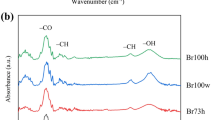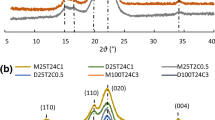Abstract
Cellulose is a biodegradable and renewable natural material that it is naturally resistant to breaking and modification. Moreover, the crystalline structure of cellulose is a major factor restricting its industrial utilization. In this study, cellulose polymorphs were prepared from natural cellulose, and their solvability and thermal response were investigated. Using liquid- and solid-state NMR signals, the distinct types and dissolving states of cellulose polymorphs were identified. The thermal behavior of the polymorphic forms of cellulose-d was also evaluated, and cellulose II exhibited the poorest thermal stability and a unique exothermic reaction.
Similar content being viewed by others
References
Ashraf M T, Thomsen M H, Schmidt J E (2017). Hydrothermal pretreatment and enzymatic hydrolysis of mixed green and woody lignocellulosics from arid regions. Bioresource Technology, 238: 369–378
Balat M (2008). Mechanisms of thermochemical biomass conversion processes. Part 1: Reactions of pyrolysis. Energy Sources. Part A, Recovery, Utilization, and Environmental Effects, 30(7): 620–635
Bertran M S, Dale B E (1986). Determination of cellulose accessibility by differential scanning calorimetry. Journal of Applied Polymer Science, 32(3): 4241–4253
Cai J, Liu Y, Zhang L (2006). Dilute solution properties of cellulose in LiOH/urea aqueous system. Journal of Polymer Science. Part B, Polymer Physics, 44(21): 3093–3101
Cai J, Zhang L N, Liu S L, Liu Y T, Xu X J, Chen X M, Chu B, Guo X L, Xu J, Cheng H, Han C C, Kuga S (2008). Dynamic self–assembly induced rapid dissolution of cellulose at low temperatures. Macromolecules, 41(23): 9345–9351
Cai J, Zhang L N, Zhou J P, Li H, Chen H, Jin H M (2004). Novel fibers prepared from cellulose in NaOH/urea aqueous solution. Macromolecular Rapid Communications, 25(17): 1558–1562
Chen J H, Wang K, Xu F, Sun R C (2014). Progress of preparing regenerated cellulose fibers using novel dissolution process. CIESC Journal, 65: 4213–4221
Chen X, Chen J, You T, Wang K, Xu F (2015). Effects of polymorphs on dissolution of cellulose in NaOH/urea aqueous solution. Carbohydrate Polymers, 125: 85–91
Chen X M, Burger C, Fang D F, Ruan D, Zhang L N, Hsiao B S, Chu B (2006). X–ray studies of regenerated cellulose fibers wet spun from cotton linter pulp in NaOH/thiourea aqueous solutions. Polymer, 47 (8): 2839–2848
Cheng G, Varanasi P, Li C, Liu H, Melnichenko Y B, Simmons B A, Kent M S, Singh S (2011). Transition of cellulose crystalline structure and surface morphology of biomass as a function of ionic liquid pretreatment and its relation to enzymatic hydrolysis. Biomacromolecules, 12(4): 933–941
Egal M, Budtova T, Navard P (2008). The dissolution of microcrystalline cellulose in sodium hydroxide–urea aqueous solutions. Cellulose (London, England), 15(3): 361–370
Himmel ME, Ding S Y, Johnson D K, Adney WS, Nimlos MR, Brady J W, Foust T D (2007). Biomass recalcitrance: Engineering plants and enzymes for biofuels production. Science, 315(5813): 804–807
Huang H, Liu Y, Chao M A, Jiyou G U (2016). Research progress in the application of cellulose and its derivatives. Materials Review, 21: 75–82
Idström A, Schantz S, Sundberg J, Chmelka B F, Gatenholm P, Nordstierna L (2016). (13)C NMR assignments of regenerated cellulose from solid–state 2D NMR spectroscopy. Carbohydrate Polymers, 151: 480–487
Ishikawa A, Okano T, Sugiyama J (1997). Fine structure and tensile properties of ramie fibres in the crystalline form of cellulose I, II, IIII and IVI. Polymer, 38(2): 463–468
Isogai A (1997). NMR analysis of cellulose dissolved in aqueous NaOH solutions. Cellulose (London, England), 4(2): 99–107
Isogai A, Usuda M, Kato T, Uryu T, Atalla R H (1989). Solid–state CP/MAS carbon–13 NMR study of cellulose polymorphs. Macromolecules, 22(7): 3168–3172
Jeoh T, Ishizawa C I, Davis M F, Himmel M E, Adney W S, Johnson D K (2007). Cellulase digestibility of pretreated biomass is limited by cellulose accessibility. Biotechnology and Bioengineering, 98(1): 112–122
Jin F, Zhang J, Chen W, Fan Q, Bai Z (2012). Preparation and chiral recognition of new chiral stationary phases derived from cellulose microspheres. Wuhan University Journal of Natural Sciences, 17(3): 205–210
Jin H, Zha C, Gu L (2007). Direct dissolution of cellulose in NaOH/thiourea/urea aqueous solution. Carbohydrate Research, 342(6): 851–858
Junior J L P (2000). Effect of cellulose crystallinity on the progress of thermal oxidative degradation of paper. Journal of Applied Polymer Science, 78: 61–66
Kono H, Erata T, Takai M (2003). Complete assignment of the CP/MAS 13C NMR spectrum of cellulose IIII. Macromolecules, 36(10): 3589–3592
Kumar P, Barrett D M, Delwiche M J, Stroeve P (2009). Methods for pretreatment of lignocellulosic biomass for efficient hydrolysis and biofuel production. Industrial & Engineering Chemistry Research, 48 (8): 3713–3729
Langan P, Nishiyama Y, Chanzy H (1999). A revised structure and hydrogen–bonding system in cellulose II from a neutron fiber diffraction analysis. Journal of the American Chemical Society, 121 (43): 9940–9946
Lennholm H, Larsson T, Iversen T (1994). Determination of cellulose I [alpha] and I[beta] in lignocellulosic materials. Carbohydrate Research, 261(1): 119–131
Liebert T, Heinze T, Edgar K J (2010). Cellulose solvents: For analysis, shaping and chemical modification. Journal of the American Chemical Society, 132: 17976–17976
Liitiä T, Maunu S L, Hortling B, Tamminen T, Pekkala O, Varhimo A (2003). Cellulose crystallinity and ordering of hemicelluloses in pine and birch pulps as revealed by solid–state NMR spectroscopic methods. Cellulose (London, England), 10(4): 307–316
Lou Y R, Kanninen L, Kuisma T, Niklander J, Noon L A, Burks D, Urtti A, Yliperttula M (2014). The use of nanofibrillar cellulose hydrogel as a flexible three–dimensional model to culture human pluripotent stem cells. Stem Cells and Development, 23(4): 380–392
Luo X, Zhang L (2010). Immobilization of penicillin G acylase in epoxy–activated magnetic cellulose microspheres for improvement of biocatalytic stability and activities. Biomacromolecules, 11(11): 2896–2903
Madaeni S S, Heidary F (2011). Improving separation capability of regenerated cellulose ultrafiltration membrane by surface modification. Applied Surface Science, 257(11): 4870–4876
Moigne N L, Navard P (2010). Dissolution mechanisms of wood cellulose fibres in NaOH–water. Cellulose (London, England), 17(1): 31–45
Mori T, Chikayama E, Tsuboi Y, Ishida N, Shisa N, Noritake Y, Moriya S, Kikuchi J (2012). Exploring the conformational space of amorphous cellulose using NMR chemical shifts. Carbohydrate Polymers, 90(3): 1197–1203
Mosier N, Wyman C, Dale B, Elander R, Lee Y Y, Holtzapple M, Ladisch M (2005). Features of promising technologies for pretreatment of lignocellulosic biomass. Bioresource Technology, 96(6): 673–686
Nishino T, Matsuda I, Hirao K (2004). All–cellulose composite. Macromolecules, 37(20): 7683–7687
Perlack R D, Wright L L, Turhollow A F, Graham R L, Stokes B J, Erbach D C (2005). Biomass as feedstock for a bioenergy and bioproducts industry: The technical feasibility of a billion–ton annual supply. Oak Ridge National Lab TN, doi: 10.2172/885984
Qin X, Lu A, Cai J, Zhang L (2013a). Stability of inclusion complex formed by cellulose in NaOH/urea aqueous solution at low temperature. Carbohydrate Polymers, 92(2): 1315–1320
Qin X, Lu A, Zhang L (2013b). Gelation behavior of cellulose in NaOH/urea aqueous system via cross–linking. Cellulose (London, England), 20(4): 1669–1677
Sarko A (1978). What is the crystalline structure of cellulose? Technical Association of the Pulp and Paper Industry, Tappi
Segal L, Creely J J, Martin A E Jr, Conrad C M (1959). An empirical method for estimating the degree of crystallinity of native cellulose using the X–ray diffractometer. Textile Research Journal, 29(10): 786–794
Teng N, Ni J, Chen H Z, Ren Q H, Na H N, Liu X Q, Zhang R Y, Zhu J (2016). Initiating highly effective hydrolysis of regenerated cellulose by controlling transition of crystal form with sulfolane under microwave radiation. ACS Sustainable Chemistry & Engineering, 4 (3): 1507–1511
Tsarevsky N V, Bernaerts K, Dufour B, Prez F D, Matyjaszewski K (2004). Well–defined (Co) polymers with 5–vinyltetrazole units via combination of atom transfer radical (Co) polymerization of acrylonitrile and “click chemistry”–type postpolymerization modification. Macromolecules, 37(25): 9308–9313
Wang J, Lin X, Luo X, Yao W (2015). Preparation and characterization of the linked lanthanum carboxymethylcellulose microsphere adsorbent for removal of fluoride from aqueous solutions. RSC Advances, 5(73): 59273–59285
Wang L H, Wang Y L, Zhao X S, Han Z (2013). Comparative study on the method of extracting straw cellulose. Zhongguo Nongxue Tongbao, 29: 130–134 (in Chinese)
Wang T, Phyo P, Hong M (2016). Multidimensional solid–state NMR spectroscopy of plant cell walls. Solid State Nuclear Magnetic Resonance, 78: 56–63
Wang Y, Deng Y (2009). The kinetics of cellulose dissolution in sodium hydroxide solution at low temperatures. Biotechnology and Bioengineering, 102(5): 1398–1405
Yang B, Wyman C E (2008). Pretreatment: The key to unlocking lowcost cellulosic ethanol. Biofuels, Bioproducts & Biorefining, 2(1): 26–40
Yui T, Okayama N, Hayashi S (2010). Structure conversions of cellulose IIII crystal models in solution state: A molecular dynamics study. Cellulose (London, England), 17(4): 679–691
Zhang J Q, Lin L, Sun Y, Mitchell G, Liu S J (2008). Advance of studies on structure and decrystallization of cellulose. Linchan Huaxue Yu Gongye, 28: 109–114 (in Chinese)
Author information
Authors and Affiliations
Corresponding author
Additional information
This work was funded by the National Natural Science Foundation of China (Grant No. 31770622), the Beijing Natural Science Foundation (Grant No. 6174046), the Fundamental Research Funds for the Central Universities (No. 2017PT13) and the China Scholarship Council (International Clean Energy Talent Programme (iCET), Grant No. 201702660054).
Rights and permissions
About this article
Cite this article
Chen, Q., Zheng, K., Fan, Q. et al. Solvability and thermal response of cellulose with different crystal configurations. Front. Eng. Manag. 6, 62–69 (2019). https://doi.org/10.1007/s42524-019-0001-z
Received:
Accepted:
Published:
Issue Date:
DOI: https://doi.org/10.1007/s42524-019-0001-z




